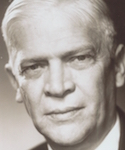2019 INTRODUCTION | PART 1 | PART 2 | PART 3 | PART 4 | PART 5 | PART 6 | LINKS
Houston, we have a space program
Forty years before NASA arrived in Houston, Albert Thomas and George Brown were students and roommates at Rice. Air travel was still a dangerous novelty, and Robert Goddard had yet to launch the world’s first liquid-fueled rocket. Neither Thomas nor Brown could have imagined the role they would eventually play in sending men to the moon or catapulting Rice and Houston onto the global stage.

George R. Brown
Thomas, who graduated in 1920, became the first congressman with a Rice degree, and Brown, who left Rice for the Colorado School of Mines, became a construction magnate with Brown and Root (now KBR) and the philanthropist for whom Rice’s School of Engineering is now named.
More than five years before Kennedy’s historic speech at Rice, Thomas and Brown were working behind the scenes to establish a major federal research facility in Houston. Brown was by then chairman of the Rice Board of Governors, and he had arranged for the powerful Humble Oil and Refining Co. to donate 1,000 acres of land near Clear Lake to Rice. The idea was to offer the land to the federal government as an incentive to locate in Houston.
Brown and Thomas’ first attempt to use the land to attract a major research facility fell through just as the U.S. was reacting to the Sputnik launch. Senate majority leader Lyndon Johnson, another Texan and political ally of Brown and Thomas, was instrumental in founding the National Aeronautics and Space Council in 1958. Shortly before he took office in 1960, Kennedy announced that Johnson, as vice president, would chair the council.
Thomas was by then the chairman of the powerful House Appropriations Subcommittee, which controlled NASA’s budget. With Thomas and Johnson on board, Brown pulled out all the stops to woo NASA officials as more than 20 other cities competed for the Manned Spacecraft Center, and Kennedy himself wanted it in Massachusetts, it was clearly Houston’s for the taking.

President Kennedy
at an appreciation dinner for Rep. Albert Thomas, right, in Houston in September 1963.
On Sept. 14, 1961 — almost a year to the day before Kennedy’s speech at Rice — James Webb, NASA’s second administrator, made his choice, delivered to JFK via memo. It read: ”Our decision is that this laboratory should be located in Houston, Texas, in close association with Rice University and the other educational institutions there and in that region.”
A week later, a team of top NASA officials toured the site southeast of downtown Houston and met the crème de la crème of Rice’s faculty at a welcoming party at the home of Franz Brotzen, then Rice’s dean of engineering and now professor emeritus in mechanical engineering and materials science.
Soon pilots, engineers and scientists began flooding into America’s new Space City.



Leave a Reply